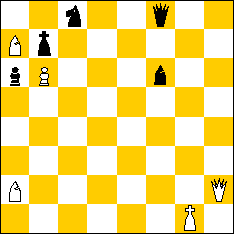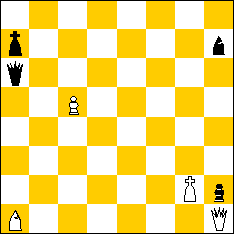Thematic Chess
Chess problem composers Mladen Vassilev-Missana and P. Zmilo from Sofia, Bulgaria proposed this variant of chess in 1997 and sent it to the Chess Variant Pages. Thematic Chess can be seen as a collection of chess variants, or perhaps better stated, as stipulations for chess problems, because it is unclear whether these variants give good playable boardgames.Missana and Zmilo also sent two original compositions that use the rule of their new variant/stipulation. You find their description of Thematic Chess, and their problems below.
Thematic Chess
What would happen if durring a chess game we require that White must realize a fixed theme (from chess composition) whenever such possibility occurs? The same requirement shall be valid with respect to Black (the theme for them might be the same, but it is not necessary).Thus way we may discover a new type of variant chess, which we shall name "Thematic chess". The mentioned themes ought to be realized if there is no prevention to this. Such prevention can be check or other reason destrojing the theme, because of the ordinary chess`rules.
When there is more than one possibility for realizing the theme, then it is the matter of choice which one to prefer.
We shall consider below an example of "Thematic chess", which we named "Novotny - Plachuta chess", or enshortend - "Novotny chess".
In this specific type of chess both Whith and Black must realize "Novotny - Plachuta" theme. We remind that "Novotny - Plachuta" theme states the following: A chess piece (or pawn) has to be put in the intersection point of paths of two long-ranged pieces from the oposite colour.
Problems
 White:
White:Kg1, Qh2, Ba2, Ba7, pawn b6.
Black:
Kb7, Qf8, Bf6, Nc8, pawn a6.
Mate in 3 moves, Novotny Chess.
Author: P. Zmilo, Bulgaria.
 White: Kg2, Qh1, Ba1, pawn c5.
White: Kg2, Qh1, Ba1, pawn c5.
Black: Ka7, Qa6, Bh7, pawn h2.
White to play and win, Inertial Novotny Chess.
Author: Missana, Bulgaria.
Written by Missana and P.Zmilo; editing and first paragraphs by Hans Bodlaender.
WWW page created: January 5, 1998.